
(Photos by Anders Hedlund)
Note: This post is from 34-year-old Anders Hedlund from Linköping, Sweden. I planned to publish this piece today before I decided to run this morning’s post about Mikael Colville-Andersen’s view of Portland. At first I thought it would be strange to post them one after another, but then figured they’d work nicely as a productive comparison. Thanks to Kiel Johnson for making this happen. – Jonathan
One year ago my wife and I left our home, two cats and all of our bikes in Sweden to move to North America ́s premier bike city for a year. Here ́s an attempt to sort out my experiences and thoughts about the PDX bike culture, and compare it to the way cycling is known in Scandinavia.
My wife Elin is a medical researcher and during the years there have been many suggestions and offers for different places to go for an exchange year. When Portland was mentioned she caught my attention – even in Europe Portland is known as a progressive hub for biking. To me, the deal was perfect: her boosting her career and me riding and working with bikes for a year.
“What’s unique to Portland’s bike scene seems to be the social aspect of riding a bike.”
When we arrived last January the rain was pouring and, the first days, I was more or less in shock from the heavy traffic in and around town. Initially I made some beginner mistakes, like crossing Ross Island Bridge on foot and riding my bike on Powell Blvd. Somehow I managed to survive both. Just when my riding confidence started to grow I mistook the pedestrian trail by Pettygroove Park for a bike path – to my surprise there where a set of stairs on the path that send me and my bike flying, with a scattered collar bone as the result. That gave me a firsthand experience with American healthcare (I ended up having to fly back to Sweden for surgery).
After a while I healed up and got the hang of the bike network, but still the sheer number of cars baffled me. Riding a bike with parked cars to the right and passing cars to the left makes you feel that the margins are quite small. For an experienced bike rider, Portland’s bike infrastructure is all right; but someone not so confident with bike handling will have a big challenge the first time. The speed (of both bikes and cars) is high, and there is no room for mistakes.
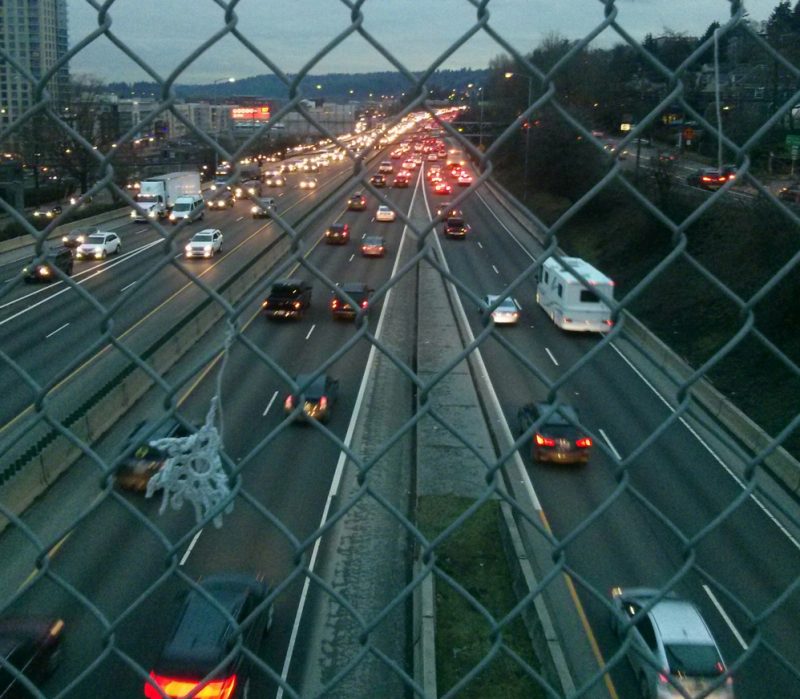
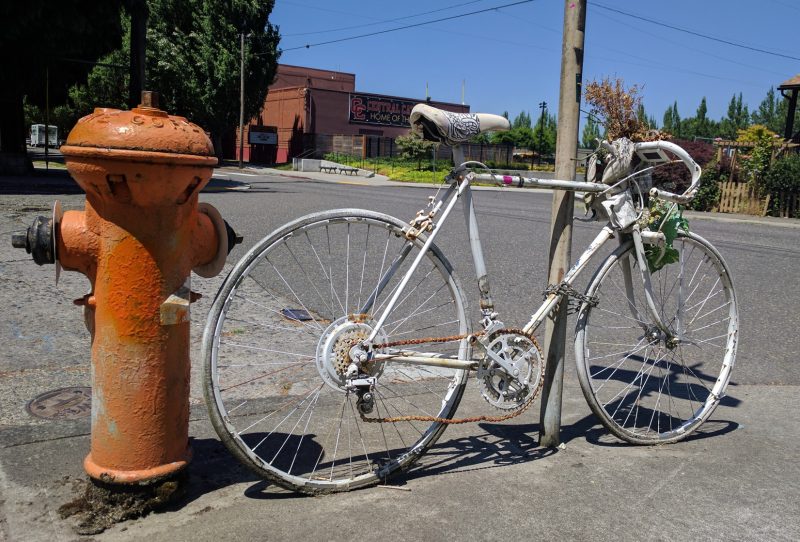
“When we arrived last January the rain was pouring and, the first days, I was more or less in shock from the heavy traffic in and around town.”
The biggest difference between most Swedish bike infrastructure and Portland’s are that Swedish bike paths is mostly off-street, only for pedestrians and bikes. There are downsides to this: for instance confusion between foot traffic and bikes, the slower speeds, and the most dangerous part – cars crossing the bike path without looking, much less yielding for cyclists. The positive side to the Swedish model is that the network of bike paths are designed to keep you safe, whether you just got rid of your training wheels or you ́ve been biking for decades. The barriers for getting on two wheels are much lower in Sweden. The bike is more often considered a form of transportation that anyone can use. The fact that around 25% of the trips in my hometown Linköping are done by bike can be compared to the 6.3% in Portland.
What’s unique to Portland’s bike scene seems to be the social aspect of riding a bike. Maybe the fact that cyclists are in such a minority on the streets creates a stronger bond between fellow riders? I don ́t know any other city that has the amount of social rides, events and different non-profits that all together make being a cyclist so enjoyable here. For me the non-profit, DIY-workshop Bike Farm became a home away from home. For most of the year I worked at Go By Bike – the bike valet by the aerial tram – where I got to meet some of the hardcore commuters in Portland ́s widespread city.
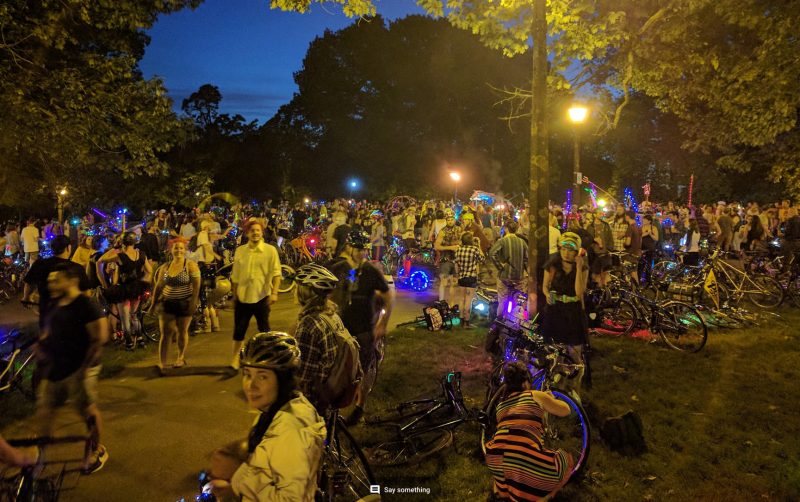
Advertisement
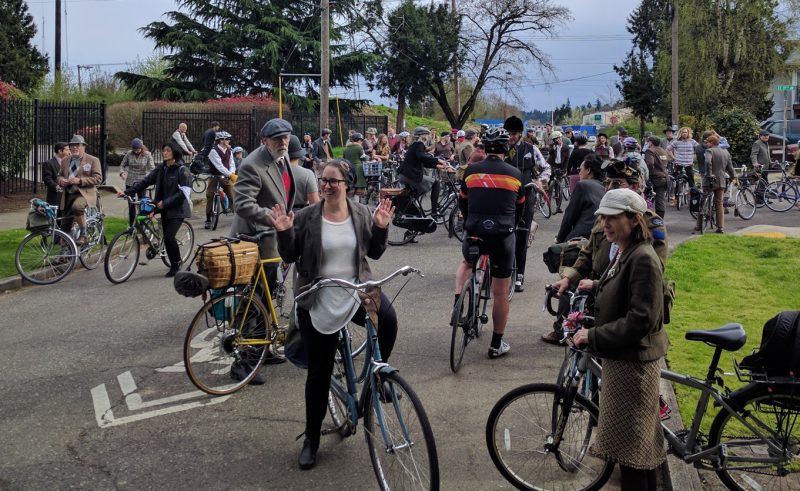
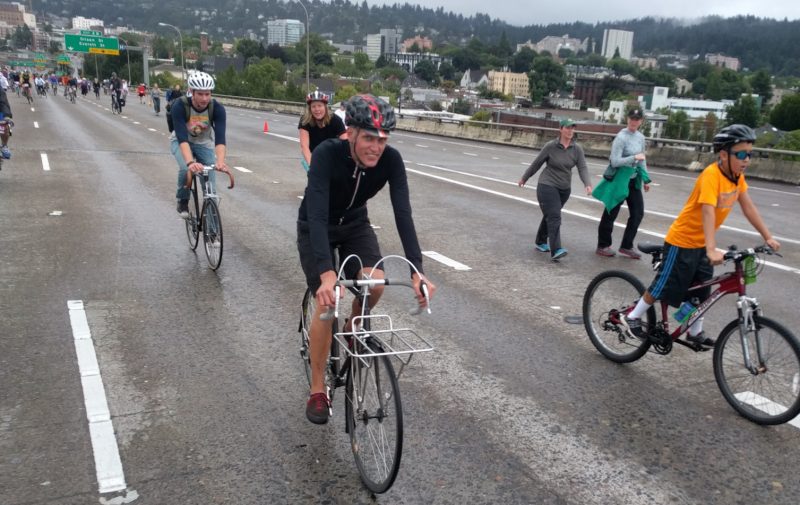
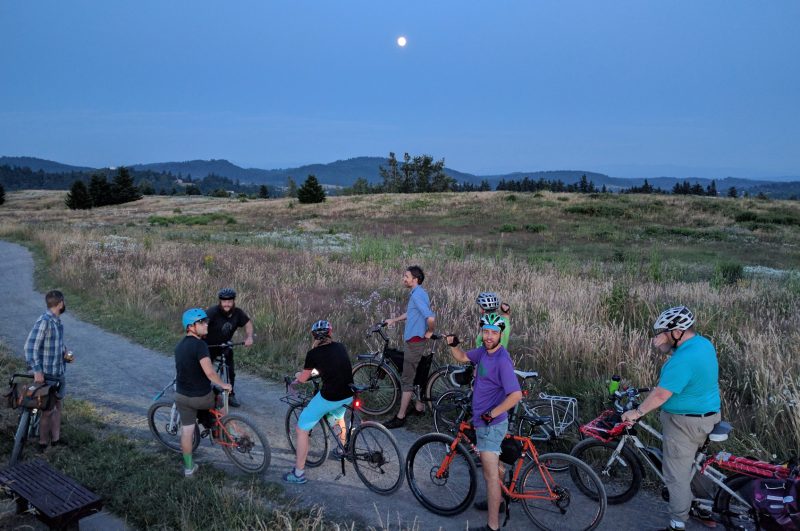
To me it seems that a big challenge for Portland – as well as most cities in the US – is the fact that cars have been allowed to dictate the way cities were built for so long. The best examples of the contradiction between the way people want to see their city and the way they behave is the joy and celebration on the streets during Sunday Parkways or Last Thursday on Alberta – only to be replaced by the usual invasion of cars when the event is over. Not to mention the contrast between imagination and reality found in the mural on NW Vaughn and 23rd Ave. These things really makes you wonder why the people of Portland don ́t demand access to the streets every day of the year.
“This city really has some great potential and an abundance of fantastic people and communities.”
Linköping is a much smaller city with around 150,000 inhabitants, built around a city center that ́s been around since the 12th century. However, the fact that modern infrastructure and city planning always have let different forms of transportation play a part makes it an easy city to get around in on foot, by bike or bus. Most of the downtown area is closed off to cars, which creates a vibrant atmosphere with thriving businesses. To live in a city that is quiet, with clean air and safe streets with few or no cars makes people warmer and more prone to interact with each other. Less traffic also means that the few vehicles that really need to be in the city will get there on time, and not be stuck in congestions. In the past years more streets in Linköping have been closed off for cars, always with some initially concerned voices that promotes cars. I dare to say that very few want to go back once the change has settled for a year or two. With this said I don ́t mean that Sweden is a cyclist utopia. There is a lot of things left to improve in bike infrastructure, but at least we ́re heading in the right direction.
We live in exciting times, to say the least. Within a few years there will be autonomous cars in the streets, which hopefully will change the way the city is used and looked upon. Less need for parking will allow the city to become denser, less human factors and emotional drivers will create a safer environment, and more efficient transportation will create less pollution and noise.
Some day I hope to come back to a Portland that takes radical steps away from the car centered living we see today. The way transportation works right now just locks people in their cars – when I look at the clogged highways I see so much human and fossil energy go to waste. This city really has some great potential and an abundance of fantastic people and communities.
For me and my wife this year in Portland is about to end. We will return to Sweden and soon give birth to our first child and enjoy a year and a half of paid parental leave. I can only wish you all the best, and I hope to see you on a bike path somewhere in a bright future.
— Anders Hedlund, @veloviner on Twitter
Never miss a story. Sign-up for the daily BP Headlines email.
BikePortland needs your support.

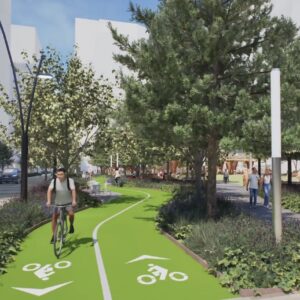

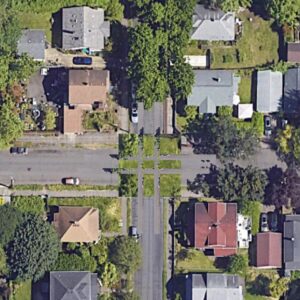

Thanks for reading.
BikePortland has served this community with independent community journalism since 2005. We rely on subscriptions from readers like you to survive. Your financial support is vital in keeping this valuable resource alive and well.
Please subscribe today to strengthen and expand our work.
So sorry about your scattered Collar-bone, so painful. I appreciate your well thought out perspective. America will never be Sweden, but we can learn from the world.
“This city really has some great potential and an abundance of fantastic people and communities.” Quite true, and something to be proud of. What Portland does not have is leadership. No amount of advocacy appears to have changed that.
If the people will lead, the leaders will follow.
Reading outside perspectives on Portland and our nation’s car culture is always a frank reminder that, despite being a national leader, we’re still completely beholden to this culture in the planning decisions we make.
I’m not so sure we’re even a national leader anymore.
Sad that to get good health care for a bike related injury he had to leave the U.S. Glad for the upcoming child and *year* of parenting leave! To your health, Anders!
*year and a half* of parental leave! Wowza! Too bad the US spends 55% of the federal budget on military.
Sweden has an interesting tax structure. It has very high marginal income tax rates (56%) that are generally very flat. The 56% kicks in on any income above 1.5x the average income. In the US the top marginal tax rate is only 46% but it only kicks in on income that is 8.5x above the average income so the US income tax is much more progressive than Sweden. If you are making 1.5x the average income in the USA you are paying a 25% marginal tax rate. Sweden also has a very large VAT (sales/consumption) tax that is also very regressive. Sweden and the US collect about the same amount of business taxes as a percent of GDP. Generally Swedish taxes hit the poor much harder but they have very generous government benefits that make up for the very regressive tax structure.
No, the top US marginal tax rate is actually 39.6%, but the new GOP tax bill just lowered that to 37%.
Sweden also is the nation with the lowest income inequality in the world (as measured by the GINI index); this redistribution is accomplished by its tax policies.
Maybe 55% of the discretionary budget on military spending, but certainly not overall. Check your “facts”.
Correct. The military is about 16.2% of the spending in the USA. Still way too high but nowhere near 55%.
“nowhere near 55%”
not so fast.
https://www.nationalpriorities.org/campaigns/military-spending-united-states/
“In fiscal year 2015, military spending is projected to account for 54 percent of all federal discretionary spending, a total of $598.5 billion. Military spending includes: all regular activities of the Department of Defense; war spending; nuclear weapons spending; international military assistance; and other Pentagon-related spending.”
And you can be sure it is higher today given Mr. Orange’s priorities.
Percentage of discretionary spending is not the same as percentage of total budget. rh claimed that the “US spends 55% of the federal budget on military”. Simply not true.
Well no matter how you slice it the amount we spend on the military dwarfs every other nation’s military budget on earth, and it is the chief reason we never seem to have any money to do useful stuff.
So splitting hairs over the denominator seems, frankly, a distraction, though it is of course important to get the number right. Let’s just not lose sight of the essential truth in the process.
I believe that the essential truth in the process is that waste and over-charges related to the healthcare-industrial complex (so called mandatory spending, as opposed to discretionary spending) is what’s going to sink us.
The 2015 budget spent: 37% Social Security, 27% (Medicare, Medicaid, & Health), 16% Defense, 6% Interest, 14% Other.
As a percentage of GDP the US spends about 3.5% on Defense. Russia spends 4.5%, Israel 5.2%, and Saudi Arabia 10.4%, India 2.4%, France 2.2%, Turkey 2.2%, UK 2.2%, China 2.1%, Australia 1.8%, Germany 1.2%, and Canada 1.0%. (2014 numbers from Forbes Magazine).
Thanks, Jon. It looks like we are spending 2-3x more on defense than we really need to. I guess policing the world has its associated costs…
We spend that much, so we can shake down the oil producing countries so we don’t run out of gas to power our cars, so we can race too work 5 days a week 50 weeks a year because we can’t afford to have long vacations or parental leave because we spend too much on the military. Whew!
We can’t have long vacations or parental leave because we spend too much on the military? That’s ridiculous.
If we cut 2/3 of our military spending, which would bring us in line with other developed countries (% of GDP spent), we would have a lot of funding for paid parental leave programs. It might not be as much as the Scandinavian countries, but it would be something.
It should be unacceptable for any new infrastructure in Portland to put cyclists in this awful position. At its best, it is highly stressful and uncomfortable and discouraging to all but the most confident riders. At its worst, it is deadly.
Maybe he’s hit upon the truth here: Portland is a great place to be a “cyclist”, but not such a great place to actually ride bicycles.
THIS EXACTLY. I consider myself an experienced cyclist, but I never want to forget how needlessly scary it was (and still is) getting here. “Normal”* people should feel comfortable and empowered to ride bikes, not just battle-scarred people like me whom drivers have hit with their cars.
*”Normal” meaning non-cyclists who think riding a bike for transportation is scary and dangerous (i.e. most people).
Sheesh. Rub it in, why don’t ya.
I think Anders sums it up perfectly. The best thing about Portland are the cyclists, and the worst thing is the motorists.
I disagree.
I personally think what passes for cycling advocacy is one of the bigger impediments to getting more people cycling. Encouraging hatred and fear of cars has no future — may as well try to instill fear and hatred of the rain.
People don’t need to like reality, but those who refuse to come to terms with it will only be marginalized.
Ironic that you think people need a lesson in cycling advocacy from a driving advocate, paired with a lesson in accepting reality.
Cyclists are currently marginalized whether or not they have come to terms with the existence of cars, BTW.
Nothing ironic about it. Curiously, I get chided via PM for talking to trolls when I engage cyclists from here in other forums.
Don’t worry, you’ll drive me off soon enough. Having every single post moderated gets with harmless stuff filtered out gets old. This site exists to propagate a very specific message and those who don’t agree get hammered.
Jonathan, if you don’t let this through, I’m gone. This isn’t personal — I get this is your site to manage as you like, but you guys are wrecking cycling and I want no part of that.
Yup, one gets tired of the strident “true believers”, zealots and reality deniers and they just step away.
Totally agree with this sentiment and I actually disagree with most of your comments. I have no idea what Jonathan is going for in his comment section but he seems to like to moderate or discredit those who disagree with his specific world view.
“he seems to like to moderate or discredit those who disagree with his specific world view”
I’m curious how exactly would we-whose-comments-are-getting-through know this? My comments have at times been heavily moderated; at other times not so much. Some folks are on auto-moderation but the only way I know this is that their comments show up in bunches and with a delay once or twice a day, but I can only say this for sure about a few posters. In the absence of more fine grained intelligence your statement strikes me as more persecution complex than factual observation.
http://bikeportland.org/comments
Lets you view all comments, including unapproved ones.
very interesting.
thank you.
Yes, that is interesting.
My last post was not meant as a complaint about moderation in general (even when it affects my own posts) as it can be a useful tool to keep discussions from becoming like those worthless ones following news articles on other sites.
But I do think that progress depends on reasonably open exchange of ideas as that’s the only way people can see the world through each others’ eyes.
“I do think that progress depends on reasonably open exchange of ideas as that’s the only way people can see the world through each others’ eyes.”
I agree wholeheartedly.
But for that to work it is equally important to hear each other; open exchange goes both ways. I sometimes feel that your penchant for putting words in others’ mouths gets in the way of your hearing (me).
Hi Clicky,
I disagree completely with your assessment. I abhor echo chambers and have worked very hard to make sure this site stays open and represents all viewpoints.
That being said, I am tired of specific commenters who dominate these threads with comments that I feel are mean in spirit/tone and that have the impact of intimidating others and preventing other voices from taking part.
So, while I understand the annoyance from the people who are being moderated and the several others who get deleted frequently, I want you to remember that there are people who are not commenting because they feel unwelcome.
It is a difficult job to moderate these comments. I am doing my best. I do have biases because I am a human and I am very far from perfect. BikePortland is one person. I have a lot of shit I’m dealing with. Please be patient and I would really appreciate your understanding. My goal is to build a team and have more people helping with things like moderation.
Again, I moderate out comments that I feel are mean-spirited and that are not productive to the conversation. This is a subjective thing and I don’t always get it right. However I am very open to feedback.
Thanks for your comments.
Banerjee… . That’s right, this is a privately owned and operated weblog. The owner gets to moderate, edit, and show preferential treatment to whatever persons, viewpoints and comments he thinks best supports whatever it is he’s trying to accomplish. I accept this, even if I can’t respect how that type of power sometimes manifests itself.
It’s terrible to be supporting viewpoints untrue, that everyone on the road driving, is indifferent to or insensitive to people not driving a motor vehicle or traveling in one. Support in the comment section of this weblog, is in my opinion, given too much to people that regard use of the road by its range of road users on foot, bike and motor vehicle, as a war between road users, which it’s not, except for the people that prefer war to working with each other.
If there is an actual war associated with general travel on streets and roads, that war is with all road users working together, to somehow arrive at feasible means to provide sufficient travel infrastructure capable of safely and at least somewhat enjoyably, allow everyone to get where they need to go on a daily basis, whether they’re walking, biking or driving.
“everyone on the road driving, is indifferent to or insensitive to people not driving a motor vehicle or traveling in one”
Again, I question this interpretation of the comments found here. Do you have a supporting quote, from anyone, that says every driver is indifferent or insensitive to every non-driver? I feel like you’re making an argument against a position that hasn’t been taken.
The only quotes I can think of to marshal in support of that view are from wspob sprinkled throughout the comments here over the years.
“Encouraging hatred and fear of cars”
Where do you get this stuff?
“This site exists to propagate a very specific message and those who don’t agree get hammered”
Weird. Maybe it isn’t that you disagree with what you perceive as the party line but that you say crazy things all the time, put words in people’s mouths. Just a thought.
“Encouraging hatred and fear of cars has no future — may as well try to instill fear and hatred of the rain.”
This is a “traffic as a force of nature” metaphor. Traffic can’t be tamed/calmed/reduced/whatever, so might as well get used to it. Drivers can’t be responsible any more than a raindrop can decide where to land. I’m sure you didn’t mean it this way, but this is a comparison that is made often, and it implies there’s nothing we can do—well, nothing but hone our ninja-like spider-sense to anticipate and nimbly evade the sharks, bears, and tigers that would eat us and dodge the hurricanes and tornadoes of mindless motor traffic. Or become a shark-whisperer and attempt to bend traffic to our will.
I agree with you to an extent. Yes, the reality is most drivers are inattentive and I personally ride assuming I am invisible. If you want to ride in this city, you have to be super defensive and assertive, assuming the worst and acting accordingly. However, if we are to “come to terms with reality” we should also acknowledge the reality that most people won’t ride if there is not dedicated infrastructure. So in your view, shouldn’t the city be building more cycling infrastructure?
Yes, but this can be only part of the solution because there’s no way to get around a populated area without vehicles and bikes crossing each others’ paths frequently.
There is also the issue of keeping the infrastructure safe since no one will ride if they’re scared of the people they’ll encounter. I personally find some of our separated infrastructure intimidating (especially during off hours), and I’ve heard others say the same.
Getting more riders out there also requires helping people feel more comfortable and capable navigating real life situations. So even if we need more separated infrastructure, we also need people who have the confidence and skills to manage situations involving vehicles they know they will encounter.
The tendency in this forum is to depict the roads as some sort of killing fields. If you really want people to choose a steel safety cage with airbags rather than active transportation, that seems like a good way to do it.
“The tendency in this forum is to depict the roads as some sort of killing fields.”
A familiar accusation but not fair or accurate in my view. To the extent that danger creeps in (to stories or comments) as a leitmotif it reflects observable and statistically verifiable risks, mostly. And beyond the simple fact of the risks is the – to me eye-opening – dimension that those who kill and maim others with their autos for the most part suffer no consequences. That is its own subject and in my view well worth our time and attention.
But bikeportland is hardly just that. The people who post here are equally knowledgeable and interested in other dimensions of bicycling, but it seems that for your chief complaint to work it is necessary for you to cast us as consumed solely with danger.
Every other post from you now is an inaccurate black & white description of the views of ‘everyone on this board’.
Kyle, developing a hatred for cars, if one is an American cyclist, IS dealing with and accepting reality.
I’d respectfully and anecdotally disagree here as well- My biggest issue here are people who threaten my mere existence without reason. I’ve had someone using every transportation mode do this at one point or another. Except for train engineers, since they have separated paths.
Wow, a year and a half parental leave…..now THAT’S progressive….! (And congrats on the soon to be birth of your first child!!)
Anders – it was a pleasure working with you at Bike Farm this past year. Thank you for all of the hours you spent helping out around here. Best wishes to you and Elin on your upcoming new adventure in parenting!
Thanks for sharing your thoughts with us Anders! I now have a great reason to visit Sweden!
Thanks Anders, and thanks for all the full moon rides!
Love it when Europeans, especially Nordics come to America with all that “America is great “ propaganda still pumping in their minds and then realize what a shitsow it all really is.
A good friend has adult twin daughters. Twin #1 married a man who was visiting here from Sweden. After going back and forth between Sweden and the US a number of times over the past decade, they have finally decided to permanently remain in Sweden where they are both finishing their (free) higher education. They are due to give birth to their first child this month. Funny enough, twin #2 just gave birth to her first child in Minneapolis.
Thanks for all the kind words everyone! I’m back in Sweden now, and miss you all. In fact, it’s raining here too now.
In response to Colville-Andersen I think he’s painting a too dark picture. Keep riding your bikes and things will slowly change, and you will have a good time while doing it. Strength in numbers.
The issue is that Portland had a real head start but seems to have rested on laurels and blown the lead.
Nice of Anders Hedlund to have offered his thoughts on Portland’s infrastructure for biking compared to that of his home town in Sweden, and Sweden in general. Something I would have liked him to explain in a little greater detail, is how the bike infrastructure in his hometown evolved to what he considers to be superior to that of Portland’s in terms of it being less exposed to some of the negative effects of motor vehicle traffic.
Did the initiative to design and build bike infrastructure relieved of motor vehicle traffic effects, come mainly from the general public, or did it come about mainly by way of initiative on the part of elected and appointed government officials?
Here in Portland and surrounding cities smaller than Portland in the Willamette and Tualitan Valleys, most people do drive, rather than walk or bike. Due to, it appears to be, their choice to mainly drive, rather than walk or bike. The general public in this area has for decades, made it clear that they expect their elected and appointed officials to design and build infrastructure primarily to support road use with motor vehicles.
There has at the same time, all along for decades, been support which seems to be growing, for the addition of and increase in expansion of bike infrastructure. Mainly though, support for road infrastructure used with motor vehicles seems to be what the vast majority of the public expects the government to do with their tax dollars assigned to transportation departments.
In short, wsbob, the answer to your questions about Nordic infrastructure are a mix of history, accessibility to good bike paths and governmental work for a sustainable world.
Linköping has for instance taken on a rather ambitious task to be CO2-neutral 2025.
(http://www.linkoping.se/bygga-bo-och-miljo/hallbara-linkoping/kampanjsidor-hallbara-linkoping/koldioxidneutralt-linkoping-2025/ sorry it’s in swedish…) To achieve this there is just not possible to keep on pretending that combustion engines can still be a part of the city. What I love about my hometown is this: they dare to act on these things, and the result is a much nicer city.
But habits are hard to break, as you point out. Here we have programs where notorious car drivers can try an e-bike for a month. Breaking bad cycles and starting good habits is sometimes easy, you just need a little push.
Thanks for your honest words on the Portland Cycling Scene, and your words of hope about improving even though it can seem dark for us. I love your last statement,
“Breaking bad cycles and starting good habits is sometimes easy, you just need a little push.”
Anders….thanks for the reply. I don’t feel what you’ve written answers my question. In simpler terms, what I’m trying to get answers to, is whether public support for investment in biking infrastructure in Sweden you feel is superior to what Portland and surrounding areas have today, derives from a broad based majority of the public.
A major problem in Portland, seems to be lack of funds provided by the public to the city’s transportation dept to adequately cover even basic road maintenance priorities such as keeping existing roads paved and free of seriously dangerous and deep potholes. Even though roads in reasonably good condition are necessary for safe travel with motor vehicles, and obviously, travel by bike as well.
It logically follows, I think, that any substantial addition to existing bike infrastructure, or revision of current design philosophy and configuration to something comparable to that of Sweden, and that involves a lot of public commitment to provide money to do the work, can most likely only happen without a much greater broad based support from the public than exists now in Portland. Maybe not a majority support, but much more than exists now. Hard cold fact, is that even on the best days for riding in Portland, commonly guessed statistic is that road mode share for bikes, is somewhere around 15 percent.
Maybe not nearly the level of public support in Portland and surrounding areas for biking, as exists in Sweden, and other places like Denmark and the Netherlands. Habits are hard to break, especially if there’s no interest in or motivation to break them. Aside from enthusiastic cyclists, recreational, commuter, in our area, my impression is that most people just aren’t particularly interested in biking instead of driving or traveling by motor vehicle.
If they were, they would be, riding that is, despite present shortcomings, and they’d be knocking on elected and appointed officials doors, writing letters and sending emails and tweets, demanding that much more of their tax money allocated to transportation budgets, be assigned to the expansion and improvement of the area’s biking infrastructure. Getting people of the general public interested in biking to the extent they’d provide the needed support, is the big challenge to meet.
Well, there is absolutely a larger base and understanding for investments in bike/ped infrastructure amongst voters here in Sweden. Generally the conservative parties try to make it easier and cheaper to drive a car, but for now it’s the social democrats that are in charge.
I would say that most people in Sweden wants to live in similar neighborhoods as most people in Portland, but here they are ok with smaller size houses, more apartments and much less cars. But, as said, anywhere you go in the world humans will most likely take the easiest path, you just have to make it easier to bike/walk/bus.
So, the public support is there, but you still need politicians that are ready to think outside the box (or car).
I agree with you on the part about being easy. How I gauge what mode I’m going to take is usually based on roughly these parameters: fastest, easiest, safest, most cost-effective. But parking is one of the biggest deciders in how people travel. If the trip is more than a couple blocks and parking is plentiful and free, people will drive. Add safe and convenient bike infra, more people will bike, but for the general population it needs to be pretty flat (easy), safe, and a convenient place to lock the bike or forget it.
“If the trip is more than a couple blocks and parking is plentiful and free, people will drive.”
Yeah, see, this is how we as a nation have shot ourselves in the collective foot/feet. By artificially depressing the retail price of gasoline/provide ample free car parking we all now (more or less) make these asinine calculations.
“Linköping has for instance taken on a rather ambitious task to be CO2-neutral 2025.
(http://www.linkoping.se/bygga-bo-och-miljo/hallbara-linkoping/kampanjsidor-hallbara-linkoping/koldioxidneutralt-linkoping-2025/ sorry it’s in swedish…) To achieve this there is just not possible to keep on pretending that combustion engines can still be a part of the city. What I love about my hometown is this: they dare to act on these things, and the result is a much nicer city.”
I just love this so much – a refreshing reminder that there are adults in the world who don’t have to act like everyone’s position is equally tenable. Who cares that the majority of people here ‘prefer’ to drive everywhere in the face of crippling pollution, blight, waste of space and resources and climate degradation? Why is it such an outrage even to suggest their position isn’t tenable, or for leaders to apply the hard nudge to make driving less comfortable? The rest of us are paying for that ‘comfort’ – it’s not like it’s just natural and free.
Thanks for your views on Portland, Anders – very interesting read!
Thank you Anders! “To live in a city that is quiet, with clean air and safe streets with few or no cars makes people warmer”.
Great article Anders. Thank you very much for taking the time to write this. And thank you for believing in and living in Portland. Best wishes on future travels, your new family member and a return trip to Portland.
Separated bike infrastructure, partially funded by developers who are currently transforming the city. Close key streets to cars entirely. Just need a leader who will take the political hit from the detractors to make it happen.
And he didn’t even mention roundabouts with stop signs (WTF)? And the large swaths of race tracks downtown (one ways).
Didn’t read the entire article but it is true that Portland is nowhere near the cycling community that the people here think it is.
suggestion to JM:
read the comments regarding moderation, and note the amount of up thumbs.
Thanks SE. I will take your comment into account.
Keep in mind that might does not make right. Just because a lot of people agree to a certain viewpoint, that doesn’t mean I will assume that is the right thing to do/think. That’s why I’m here… to take feedback, but to also use my own judgment.
And yes, I am constantly checking my biases and trying to make sure I am not falling way out of line with the prevailing feelings of the community. I know how that happens to people who think “I know best” and they end up losing their way.
I really appreciate Anders’ frank assessment and I think we need much more of this honesty. I came to Portland 10 years ago from a mid-sized midwestern city that is rated “Gold” for biking, and had made major improvements over the previous decade in terms of new paved off-street bike paths (most of which were built whole-cloth, not in tiny fragments, connect all major destinations, form loops, and get people out of the city), and generally new bike/ped infrastructure everywhere. Bike mode share went way up, even in the freezing, snowy winters.
Since arriving in “Platinum” PDX I’ve felt that Portland is the emperor with no clothes–everyone keeps telling themselves this story about our fabulous bike infrastructure, which BARELY EXISTS. The “business veto” blocks no-brainer bike infrastructure from being built (NE 28th Ave.), car-centric PBOT engineers turn good projects into poor ones (SW 1st); ODOT delays for years building direly needed safety projects; we develop some meager “Bike Boulevards” that are merely a few sharrows and turned stop signs (while Berkeley, Madison, and many other cities build them with clear signage, physical traffic calming, etc.); a long-promised Central City bike plan simply never transpires; we tolerate insane, tragic numbers of pedestrian/biker deaths; and the city refuses to raise (or spend) the revenue needed to actually live up to our (undeserved) reputation. Portland wants to do it “on the cheap,” and without pissing off any drivers or business owners. That’s not the way to a world-class bike city.
I am thankful for BikePortland, and for the obviously large community of passionate bike advocates here, but folks–something really still isn’t working. Yes, there will soon be new bike/ped bridges built over I-84 and I-405, and other small-scale (often unconnected) improvements, but where is the real political will and the new revenue to prioritize and develop major, connected, physically buffered new biking and pedestrian infrastructure in a big way–an ambitious way–like NY, Seattle, Washington DC, Minneapolis, and others are doing. Thank you, Anders, for reminding us that the emperor has no clothes.